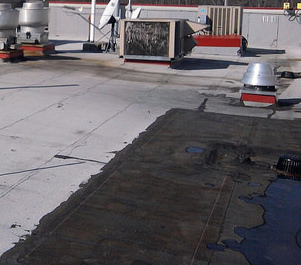Flat Roof Drain Maintenance: When and How To Inspect Your Internal Drainage Systems
 On large, flat roofs, mainly on commercial buildings or large residential complexes, you’ll likely find internal drainage systems.
On large, flat roofs, mainly on commercial buildings or large residential complexes, you’ll likely find internal drainage systems.
Unlike scupper or gutter drainage systems, in which water flows off the side of the roof, internal systems allow for drains to be strategically placed throughout a roof deck to ensure water doesn’t pool.
Each drain connects to piping that runs through the building taking water to the ground or sewer.
The Challenge with Flat Roof Inner Drainage Systems
While there are plenty of advantages to inner roof draining systems—including little fear of pipes freezing and drainage in low or enclosed areas—they can have a few drawbacks. Namely, if a drain clogs, the water pools on the roof deck.
If this happens:
- Caulk, tar or roofing cement can deteriorate.
- Improperly sealed roofing seams can weaken, especially as water expands and contracts in gaps with changing temperatures.
- The roof structural supports can weaken from the strain of the excess water weight.
- Your roof may become the world’s largest birdbath.
In addition, with internal piping, leaks have nowhere to go but into the building. To make matters worse, the effects are usually hidden from view. This can cause:
- Rust or the rotting of internal support structures.
- Mold issues.
- Escalation from a simple repair to a full-blown construction project.
For this reason, it’s essential to regularly inspect your flat roof drains.
How Frequently to Inspect a Flat Roof Drain
At minimum, you should inspect flat roof drains once a month. Other times to inspect roof drains, include:
- After a storm, especially one with heavy winds and/or hail.
- In the fall, daily if the roof is exposed to leaves and other debris.
- Following any sort of roof construction or maintenance work that may have damaged a drain or the surrounding material.
- Daily if your roof drain cover (or dome) has small or thin slots that get clogged easily.
What to look for when inspecting a flat roof drain
Following is a checklist of what to look for when inspecting your flat roof drains, along with some suggestions on how to address any issues:
Ponding water or discoloration of the roof surface around the drain can indicate that water regularly pools in that area. To resolve, test for a clog deeper in the drain piping, or consult a construction or drain professional about whether you need a larger drain outlet to handle the volume of water.
Debris may buildup around the drain dome (or cover), within the drain bowl or outlet, as well as the connected piping. Clean any debris to ensure water can flow freely.
Cracks of any size in the drain domes, rings, bowls or piping can leak, or lead to larger issues down the road. Water in these cracks will expand and contract with changing temperatures, escalating any leaks. If you find any damaged parts, replace them as soon as possible.
Rust forming on drains, piping, connectors or fasteners may cause connections to loosen and lose their watertight qualities, leading to leaks. Any rusted drain parts should be replaced immediately.
Loose, buckled or damaged flashing can cause it to pull away from the drain. In these situations, replace any damaged parts and consider hiring a professional contractor to repair the issue.
Roofing material that is cracked, torn or punctured, as well as gaps or bubbles in the material seams around the drain should be repaired or replaced. Consider working with a professional roofer.
Gaps or cracks in caulking or tar around the drain need to be repaired. For larger issues, contact a professional contractor. If the gaps or cracks are small, repair the issue with a similar caulk or tar. Then, check the roof after any rain for pooling around the drain. If so, check or remove any clogs.
If you need replacement flat roof drains or parts, or simply want to speak to a drain expert, Hy-Tech Roof Drains is your source for competitively priced products, fast shipping, and immediate, knowledgeable support.
Photo Credit: McDonald's Roof

